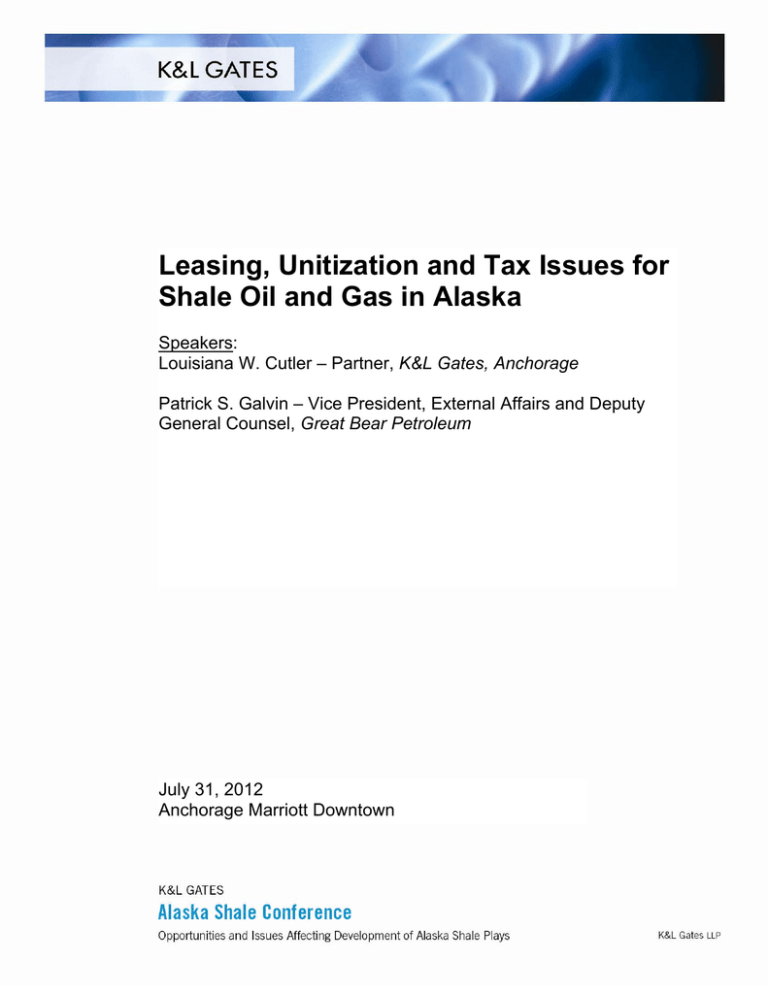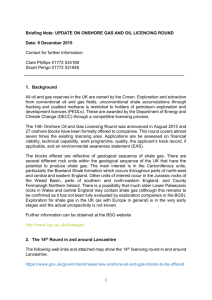
Leasing, Unitization and Tax Issues for
Shale Oil and Gas in Alaska
Speakers:
Louisiana W. Cutler – Partner, K&L Gates, Anchorage
Patrick S. Galvin – Vice President, External Affairs and Deputy
General Counsel, Great Bear Petroleum
July 31, 2012
Anchorage Marriott Downtown
Contents
“Leasing, Unitization and Production Tax Issues Presented by Shale Oil
Exploration and Development in Alaska” ................................................... A
Biographies ................................................................................................. B
Louisiana W. Cutler
Patrick S. Galvin
Supplemental Information ........................................................................... C
DNR Leasing/Unitization Statutes and Regulations
Standard Unit Form
11 AAC 83.306 Application Requirements
K&L Gates LLP
Lease, Unitization and Production Tax Issues
Presented By Shale Oil Exploration and
Development in Alaska
Louisiana W. Cutler
Copyright © 2011 by K&L Gates LLP. All rights reserved.
We are going to discuss …
1. How Shale Oil Exploration, Development and
Production May Be Impacted by Alaska’s Current
Leasing and Unitization Rules
2. How Shale Oil Exploration, Development and
Production May Be Impacted By Alaska’s Current
Production Tax Structure and Credits
1
Leasing and Unitization Applied
to Shale Oil Development
2
Leases and Units: Conventional plays
Leases generally have a 7-10 year term
Formation of a Unit extends the lease term
Units “promote conservation of all natural resources,
including all or part of an oil or gas pool, field or like
area” 11 AAC 83.303(a)(1); see also AS 38.05.180(p)
Conserving resources and avoiding waste are
significant goals of Unit formation
Conventional development involves access to a pool or
reservoir that is developed through numerous wells in a
spacing pattern within acreage limitations in order to
avoid waste
3
Shale oil development and unitization
Unlike conventional oil pools or reservoirs, shale oil is
“unlocked” from shale oil formations that are regional in
scope across the North Slope
Generally speaking, shale oil wells will access only the
oil that is proximate to that well, and will likely not be in
communication with other wells, unlike conventional
wells producing from the same reservoir or pool
The lack of communication between the wells reduces
the justification for shale resource based units if solely
premised on subsurface waste considerations
4
Shale oil development and unitization (cont)
If wells are functionally independent of one another,
leaseholders may not need to form Units to avoid
waste and conserve resources
However, the extent of the shale resources is so broad
that it may not be in the State’s interest to see every
lease developed in the next 7 to 10 years
The standard lease term may not be long enough to
accommodate rational development of all such shale
resources if the economic imperative requires
leaseholders to drill into every lease in order to retain
the acreage
5
Shale oil development and unitization (cont)
Do the current unitization statutes and regulations
accommodate formation of new Units that are not
constituted around the traditional notion of a pool or
reservoir?
Does a shale formation that spans multiple separate leases
constitute a “like area” as that term is used in AS 38.05.180(p)
and 11 AAC 83.303(a)(1)?
Will a shale formation spread across many separate leases
constitute a “potential hydrocarbon accumulation” under 11 AAC
83.395(5)? If so, it would appear to fit within the definition of
“Unit” in 11 AAC 83.395(7). See also 11 AAC 83.356(a).
6
Shale oil development and unitization (cont)
Will modifications to the standard State unit
agreement form be needed to accommodate shale
oil exploration, development and production? 11
AAC 83.306(5); 11 AAC 83.326(b); Standard Unit Agreement
Does the participating area regulation, 11 AAC
83.351,adequately accommodate shale oil exploration,
development and production?
Does the unit contraction and expansion regulation, 11 AAC
83.356, adequately accommodate shale oil exploration,
development and production?
7
Shale oil development and unitization (cont)
Can AS 38.05.180(p) [Units], (s) [drilling
agreements] or (t) [drilling contracts] be used to
address shale oil exploration, development and
production?
Will AS 31.05.100 (AOGCC authority to establish
drilling units) or AS 31.05.110 (AOGCC authority to
establish compulsory units) be used to address
shall oil exploration, development and production?
Alternatively, may need to explore changes to the statutes and
regulations in order to address the needs of shale oil exploration
and development to minimize waste, conserve resources, and
have intelligent planning and development of infrastructure, land
use, etc.
8
Summary
Current leasing and unitization system
should be reviewed to determine if it will
promote exploration, development and
production of shale oil in a measured,
deliberate way that ensures appropriate
sub-surface development and avoids a
land rush Wild West atmosphere
9
Application of Alaska Production
Tax Structure and Credits to
Unconventional Exploration and
Development Projects
10
How the Alaska Production Tax System Works
Net Profits Approach with Aggressive Tax Credits (or
“Rebates”)
Intended to Reward those who invest/re-invest in
Alaska projects
State assumes exploration risk and low-price risk
Steep Progressivity Rate
State takes an increasing share at higher prices
Disincentive for new investment looking at “upside”
potential
However, it also increases the marginal value of new
(or on-going) investment
New investment immediately lowers a taxpayers’ per
barrel profit lowers tax rate on all current production
11
Sample Production Tax Credits
Capital Expenditure Credits (20% of costs)
Exploration Credits (30% - 40% of costs)
Net Operating Loss Credits (25% of losses)
Small Producer Credits (up to $12M to reduce
tax burden)
12
Credits may be claimed in up to two ways:
(1) All Credits may be applied against tax liability
(2) Some Credits may be converted into a
transferable Tax Credit Certificate
13
New Entrants Exploring for Shale Oil
• Assume a new entrant with no current
production pursues exploration of shale oil
requiring $200 million in investment
• Company receives a 20% - 40%
investment credit (depending on location),
worth $40 - $80 million
• Company also receives an additional 25%
credit for its “tax loss” or “net operating
loss (NOL)”, worth up to $50 million
• Total State Participation is $90 - $130M of
the investment costs.
• State pays this rebate to the Company
regardless of whether the exploration is
successful.
$200 Million
-$40 Million
-$50 Million
$110 Million
(or as low as $70M at
risk for Co.)
14
Existing Producers Drilling for Shale Oil
•
Company with current production has an annual
capital budget requiring a $200 million investment
•
Company receives a 20% capital investment credit,
worth $40 million
•
$200 Million
-$40 Million
By reducing their Production Tax Value (PTV), the
company reduces their taxes by the total capital
expense multiplied by their tax rate:
Base: $200 million * 25% worth $50 million; plus
Progressivity: $200 million * progressivity surcharge
rate (which is reduced due to the drop in PTV per bbl)
•
Total State Participation is over $90M of the annual
capital costs.
• If prices are high, then state participation can
exceed 75% of the costs.
-$50+ Million
<$110 Million
(at risk for Co.)
15
Summary
•
Alaska’s Production Tax structure benefits the capital
outlay requirements of Unconventional Development
• Immediate deduction of capital and operating
expenses provides the ability to keep per barrel
taxable value low each year
•
•
The structure benefits unconventional development
such as shale oil because of the relatively constant
level of spending each year on new wells versus
conventional development’s large spending outlay
up front and relatively lower spending thereafter
State will Provide Cash Payments for Credits
Earned Beyond Your Tax Liability
16
Thanks for listening.
17
Louisiana W. Cutler
AREAS OF PRACTICE
ANCHORAGE OFFICE
Louisiana (“Louann”) Cutler advises clients in Alaska on a variety of legal matters,
including oil and gas issues, taxation; legislation and ordinance drafting; elections;
administrative proceedings; constitutional law questions; contracts and other legal
document drafting. She has more than 20 years of experience with complex litigation
with an emphasis on environmental issues and oil and gas taxation and royalties. She
has litigated such matters in Alaska trial and appellate courts, as well as administrative
hearings and arbitrations. Louann became a partner in January 1997.
907.777.7630 TEL
907.865.2475 FAX
PROFESSIONAL BACKGROUND
louisiana.cutler@klgates.com
Before joining the firm, Louann worked as special assistant to Sen. Al Adams from
1982 to 1987, who was a representative and chair of the House Finance Committee.
As special assistant, Louann conducted policy, fiscal, and political analysis of all
legislation in the House Finance Committee and performed various research projects
including oil and gas industry tax reform, impact on local communities of proposed oil
and gas development in the Arctic National Wildlife Refuge, and funding problems of
the health care system for Alaska Natives. Louann served as legislative aide to Rep.
Thelma Buchholdt from 1980 to 1982, researching and drafting legislation.
PROFESSIONAL/CIVIC ACTIVITIES
Louann is a member of various sections of the Alaska Bar Association, the Alaska
Municipal League, and the Alaska Municipal Attorneys Association. In the past, she
has served on various non-profit boards including the United Way of Anchorage,
Alaska.
COURT ADMISSIONS
U.S. Court of Appeals for the Ninth Circuit
U.S. District Court for the District of Alaska
BAR MEMBERSHIPS
Alaska
EDUCATION
J.D., Northeastern University, 1990
B.A., Yale University, 1978 (with distinction)
Patrick S. Galvin
Vice President, External Affairs and Deputy General Counsel
Great Bear Petroleum Operating LLC
Pat Galvin has extensive experience in Alaska oil and gas matters. Prior to joining Great Bear in April
2012, he was a partner in the K&L Gates Anchorage office. Prior to joining K&L Gates, Mr. Galvin
worked for the State of Alaska, most recently as the Commissioner of Revenue serving as the
Governor’s principal advisor on state fiscal issues. He has also held positions as Petroleum Land
Manager for the Department of Natural Resources and Director of the Division of Governmental
Coordination for the governor’s office.
Pat holds an MBA from San Diego State University, a JD from the University of San Diego, and a B.A.
from the University of California, San Diego.
K&L Gates LLP






